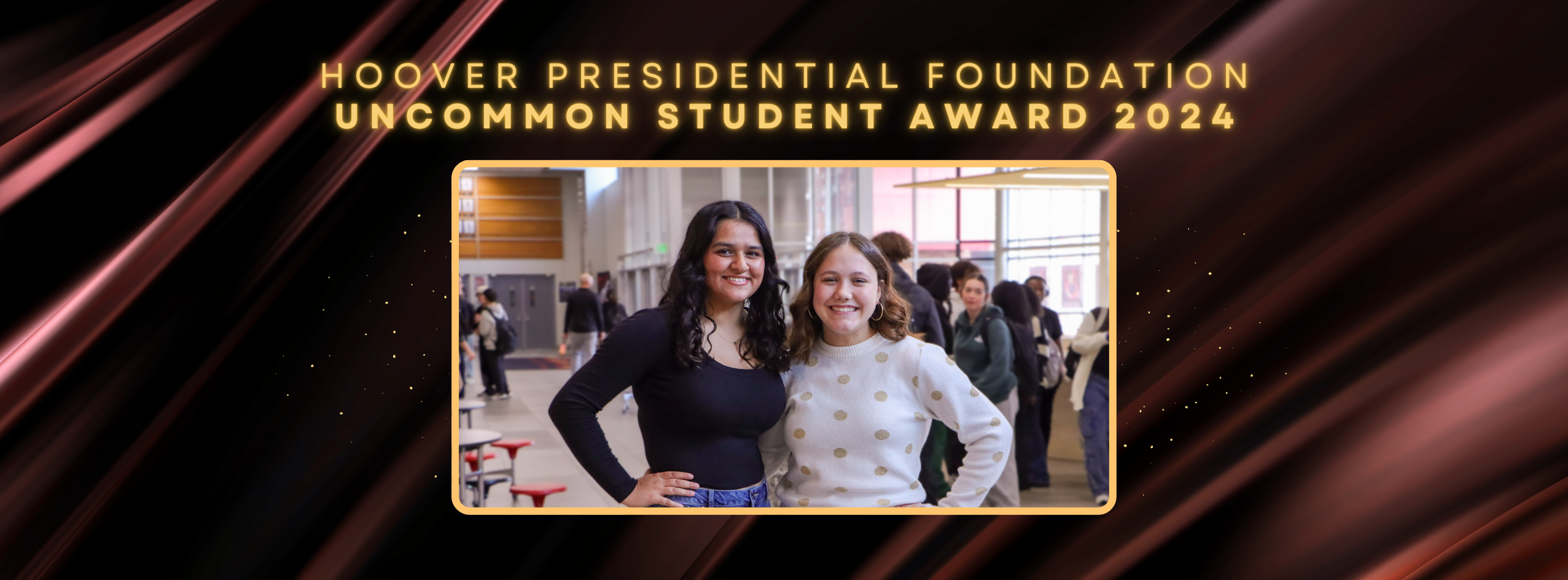
Linn-Mar Students Awarded for Their Community-Focused Projects
Two Linn-Mar High School seniors joined others from across Iowa in presenting their community-focused projects at the Herbert Hoover Presidential Library and Museum earlier this month for the Uncommon Student Award. Linn-Mar’s Gabrielle Biedermann and Ananya Oli submitted their project proposals earlier this year and this month were awarded $1,500 toward their secondary education. Gabrielle Biedermann was also one of four students to receive an additional $10,000 toward her future education.
The Reaction Project: Putting the Action into Reactions by Spreading Awareness of Food Allergies and Related Mental Health
Gabrielle Biedermann’s project focuses on raising awareness about anaphylactic food allergies and their impact on mental health. As someone who has lived with severe food allergies her entire life, Gabrielle has personally experienced the physical, emotional, and social challenges these allergies can present. Motivated by a lack of discussion around the mental health effects of living with such an invisible disability, she set out to create a project that would both educate others and provide tangible support for those affected.
Gabrielle first developed an educational letter for teachers titled “What I Wish My Teacher Knew.” The letter shares her personal experiences, both positive and negative, with the aim of helping educators better support students with food allergies. This letter is currently being distributed to all teachers in the Linn-Mar School District. In addition to the educational component, Gabrielle created 112 non-food goody bags for allergy-sensitive students around Halloween, helping them feel included during a time when food is often a central focus of celebrations.
After volunteering at the HACAP food reservoir, Gabrielle noticed a lack of allergy-friendly food options, prompting her to take further action. Recognizing the struggles of individuals facing both food insecurity and food allergies, she expanded her project to include a food drive. With the help of family, friends, and local businesses, Gabrielle raised over $1,300 and secured discounts and vouchers from grocery stores and food manufacturers. She was able to provide 2,712 servings of allergy-friendly non-perishable food to community food pantries, including those in Hiawatha, Marion, Cedar Rapids, Linn-Mar High School, and the University of Iowa campus.
Gabrielle’s motivation for the project stemmed from a question during a speech presentation when a judge asked her about the mental health impacts of living with food allergies. This led her to reflect on her own experiences growing up, when her allergies often made her feel isolated and different. “The whole inspiration for my project was to help people with allergies feel heard and valued, and educate those with allergies on what it feels like to live with this invisible disability,” Gabrielle said.
Despite the complexity of managing the project alongside her school and personal commitments, Gabrielle was determined to provide both educational resources and practical support to others. Although she may never see the direct impact of her work, she believes that any positive effect, no matter how small, will make her efforts worthwhile. She credits much of her success to the support of her parents, especially her mother, who helped with logistics and communication.
Today’s Voters, Tomorrow’s Future
Ananya Oli’s project, “Today’s Voters, Tomorrow’s Future,” was designed to encourage young people, particularly high school seniors, to vote. Recognizing that young adults aged 18-24 have the lowest voter turnout of any age group, Ananya aimed to simplify the voting process and make important information more accessible for first-time voters.
Ananya’s project involved creating pamphlets that provided essential voting information, including how to register, what a ballot looks like, and key voting deadlines. She distributed these pamphlets to high school seniors at Linn-Mar High School and other local schools. In addition, Ananya used social media platforms to share information about voting, including posts with deadlines and relevant resources. She also gave a speech at a local library to further promote the importance of voting, especially among youth.
To ensure her project addressed the needs of young voters, Ananya first conducted research and spoke with students to determine what kind of information they would find helpful. Using their feedback, she designed the pamphlet and crafted her social media messages to be clear and concise. “This goal was to simplify the voting process, specifically for youth, by increasing accessibility to important information about voting and questions that people may have,” Ananya said.
Ananya’s project specifically targeted high school seniors who were preparing to vote for the first time. By making information about voting more accessible, she hoped to inspire these students to take an active role in their democracy and to understand the significance of their vote. The outcome she sought was to increase voter confidence and participation among young people, encouraging them to engage in the voting process and make their voices heard.
Although Ananya worked independently on the project, she received assistance from Mrs. Hajek, who helped her brainstorm ideas, and from volunteers who assisted with folding the pamphlets. The project’s success will be measured by how many young people feel more informed and confident about voting, and by how many are inspired to vote in future elections.
